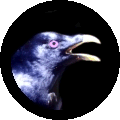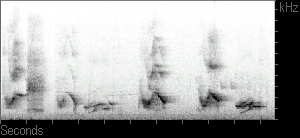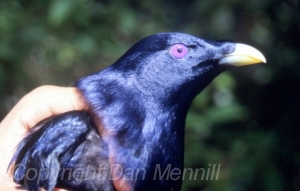 Satin
Bowerbird
Satin
Bowerbird Ptilonorhynchus violaceus
 Figure 1. Spectrogram of the
Satin Bowerbird song.
Figure 1. Spectrogram of the
Satin Bowerbird song. (The first 10-seconds from the sound file are depicted.)

Satin Bowerbird - Ptilonorhynchus violaceus
Male satin bowerbirds have many features that attract female satin bowerbirds. Firstly, males have brilliant, satiny blue feathers, bright lavender eyes, and a contrasting pale yellow bill. Female satin bowerbirds, on the other hand, are a camouflaged green colour. Detailed analysis of satin bowerbird feather colour reveals that the highest-quality males have the brightest blue plumage.
Secondly, every adult male satin bowerbird clears a circular area on the rainforest floor and builds a stick structure called a ‘bower’. Each male decorates his bower with yellow and blue objects which he collects from his environment. The objects found on their bowers range from flowers and berries to snail shells and parrot feathers, and may even include human-manufactured objects such as pen caps and toy helicopters.
Lastly, male satin bowerbirds have a large repertoire of very distinctive songs. Their long-distance advertising songs are loud vocalizations typically given by a male as he perches in the understory above his bower. Advertising songs include scratchy hisses, called ‘skraa’ calls, which satin bowerbids share in common with other species of bowerbird. Advertising songs also feature loud whistled shrieks, which have an eerie sound as though they originate from two distinct voices. The first third of the above sound file includes both of these advertising song elements. Males also sing much quieter and more highly variable songs, as heard in the middle third of the sound file. These songs are a jumble of musical phrases and mechanical whirring sounds. Satin bowerbirds also imitate the vocalizations of birds that share their environment.
James Nicholls of the University of Queensland has documented substantial variation in the advertising song between different populations of satin bowerbirds. James suggests that this variation may be tied to the different habitat features in which these populations live.
Habitat.
Satin bowerbirds are found in rainforest and eucalypt forest during the breeding season, but may travel to nearby parks and gardens during the winter.
Range.
Two subspecies of satin bowerbird are found along the eastern coast of Australia. The P. v. violaceus subspecies lives in the rainforests of northeast Queensland. This is the subspecies I have recorded here. The southern subspecies, P. v. minor, occupies a much broader range extending from Brisbane south to Melbourne.
Further Reading.
Stephanie Doucet studies the
evolution of colourful plumage and the colour of Satin Bowerbird
ornaments. You can read about her research at her homepage:
http://www.auburn.edu/~doucest/
S. M. Doucet & R. Montgomerie. 2003. Multiple sexual ornaments in satin bowerbirds: UV plumage and bowers signal different aspects of male quality. Behavioural Ecology. 14:503-509.
S. M. Doucet & R.
Montgomerie. 2003. Bower location and orientation in satin bowerbirds:
maximising the conspicuousness of male display? Emu 103:105-109.
G. Patricelli, J. A. C. Uy, G. Walsh, & G. Borgia. 2002. Male displays adjusted to female’s response – Macho courtship by the satin bowerbird is tempered to avoid frightening the female. Nature 415:279-280.
No recordings, photographs, or other information may be used without written permission (email me at dmennill AT uwindsor DOT ca).